Case Study 1: Philip and Jennifer Brown
69 Pages19259 Words1 Views
Added on 2023-01-07
About This Document
This case study focuses on the financial situation and loan requirements of Philip and Jennifer Brown, a young couple looking to buy their first home. It includes details of the property they wish to purchase, their financial and employment details, and the loan features they require.
Case Study 1: Philip and Jennifer Brown
Added on 2023-01-07
ShareRelated Documents
Written Project
Certificate IV in Finance and Mortgage
Broking(CIVMB_AS_v5A2)
Student identification(student to complete)
Please complete the fields shaded grey.
Student number
Written projectoverall result (assessor to complete)
First submission Not yet demonstrated
Resubmission (if applicable) Not applicable
CIVMB_AS_v5A2
Certificate IV in Finance and Mortgage
Broking(CIVMB_AS_v5A2)
Student identification(student to complete)
Please complete the fields shaded grey.
Student number
Written projectoverall result (assessor to complete)
First submission Not yet demonstrated
Resubmission (if applicable) Not applicable
CIVMB_AS_v5A2
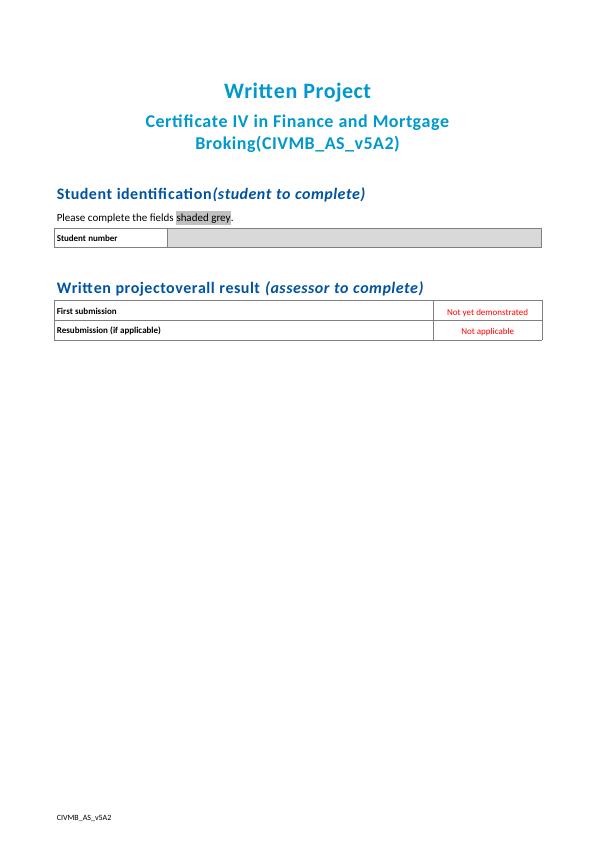
Result summary(assessor to complete)
Section 1: Case study 1 — Philip and Jennifer Brown First submission Resubmission (if required)
Task 1 — Key terms, gathering and documenting client information Not yet demonstrated Not applicable
Task 2 — Assessing the clients’ situation Not yet demonstrated Not applicable
Task 3 — Borrowing options Not yet demonstrated Not applicable
Task 4 — Reasonable enquiries Not yet demonstrated Not applicable
Task 5 — First Home Owners Grant and home buyer assistance schemes Not yet demonstrated Not applicable
Task 6 — Professional network and loan settlement process Not yet demonstrated Not applicable
Task 7 — Interest rates Not yet demonstrated Not applicable
Section 2: Case study 2 — Richard and Pauline Jackson
Task 8 — Establishing level of financial knowledge Not yet demonstrated Not applicable
Task 9 — Responsible lending obligations Not yet demonstrated Not applicable
Task 10 — Self-employed special considerations Not yet demonstrated Not applicable
Task 11 — Advising on strategies Not yet demonstrated Not applicable
Task 12 — Impact of credit history Not yet demonstrated Not applicable
Task 13 — Dispute resolution Not yet demonstrated Not applicable
Task 14 — Effective access to files Not yet demonstrated Not applicable
Section 3: Case study 3 — Mary Jane Smith
Task 15 — Prepare and check a loan application Not yet demonstrated Not applicable
Section 4: Working in financial services
Task 16 — Financial services legislation and industry codes of practice Not yet demonstrated Not applicable
Task 17 — Design a document Not yet demonstrated Not applicable
Task 18 — Applying principles of professional practice to work in the financial
services industry Not yet demonstrated Not applicable
Task 19 — Develop and maintain in-depth knowledge of products and
services used by an organisation Not yet demonstrated Not applicable
Please note:To pass this written project, you will need to be assessed as DEMONSTRATED in either your
first submission or your resubmission in all tasksabove.
Task feedback
Please refer to the assessor’s detailed feedback found at the end of each task so that you know what to do
for any tasks you need to resubmit.
Page 2 of 69
Section 1: Case study 1 — Philip and Jennifer Brown First submission Resubmission (if required)
Task 1 — Key terms, gathering and documenting client information Not yet demonstrated Not applicable
Task 2 — Assessing the clients’ situation Not yet demonstrated Not applicable
Task 3 — Borrowing options Not yet demonstrated Not applicable
Task 4 — Reasonable enquiries Not yet demonstrated Not applicable
Task 5 — First Home Owners Grant and home buyer assistance schemes Not yet demonstrated Not applicable
Task 6 — Professional network and loan settlement process Not yet demonstrated Not applicable
Task 7 — Interest rates Not yet demonstrated Not applicable
Section 2: Case study 2 — Richard and Pauline Jackson
Task 8 — Establishing level of financial knowledge Not yet demonstrated Not applicable
Task 9 — Responsible lending obligations Not yet demonstrated Not applicable
Task 10 — Self-employed special considerations Not yet demonstrated Not applicable
Task 11 — Advising on strategies Not yet demonstrated Not applicable
Task 12 — Impact of credit history Not yet demonstrated Not applicable
Task 13 — Dispute resolution Not yet demonstrated Not applicable
Task 14 — Effective access to files Not yet demonstrated Not applicable
Section 3: Case study 3 — Mary Jane Smith
Task 15 — Prepare and check a loan application Not yet demonstrated Not applicable
Section 4: Working in financial services
Task 16 — Financial services legislation and industry codes of practice Not yet demonstrated Not applicable
Task 17 — Design a document Not yet demonstrated Not applicable
Task 18 — Applying principles of professional practice to work in the financial
services industry Not yet demonstrated Not applicable
Task 19 — Develop and maintain in-depth knowledge of products and
services used by an organisation Not yet demonstrated Not applicable
Please note:To pass this written project, you will need to be assessed as DEMONSTRATED in either your
first submission or your resubmission in all tasksabove.
Task feedback
Please refer to the assessor’s detailed feedback found at the end of each task so that you know what to do
for any tasks you need to resubmit.
Page 2 of 69
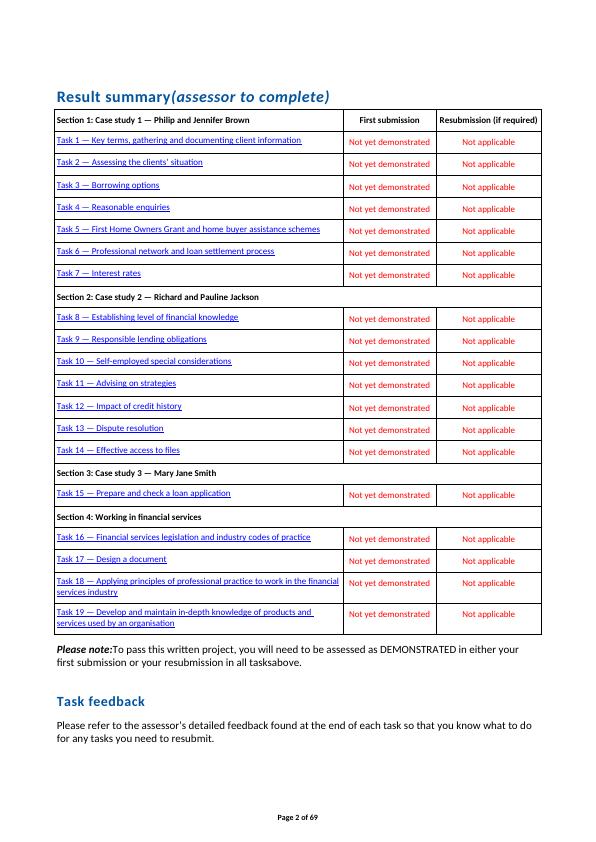
Before you begin
Read everything in this document before you start your written projectforCertificate IV in Finance and
Mortgage Broking (CIVMB_ASMG_v5A2).
About this document
This document is the written project— half of the overall Written and Oral Project.
This document includes the following parts:
• Instructions for completing and submitting this project
• Section 1: Case study 1 — Philip and Jennifer Brown
A case study with a series of short-answer questions:
– Task 1 — Key terms, gathering and documenting client information
– Task 2 — Assessing the clients’ situation
– Task 3 — Borrowing options
– Task 4 — Reasonable enquiries
– Task 5 — First Home Owners Grant and home buyer assistance schemes
– Task 6 —Professional network and loan settlement process
– Task 7 — Interest rates
• Section 2: Case study 2 — Richard and Pauline Jackson
A case study and a series of short-answer questions:
– Task 8 — Establishing level of financial knowledge
– Task 9 — Responsible lending obligations
– Task 10 — Self-employed special considerations
– Task 11 — Advising on strategies
– Task 12 — Impact of credit history
– Task 13 — Dispute resolution
– Task 14 — Effective access to files
• Section 3: Case study 3 — Mary Jane Smith
A case study and a series of short-answer questions:
– Task 15 — Prepare and check a loan application
• Section 4:Working in financial services
– Task 16 — Financial services legislation and industry codes of practice
– Task 17 — Design a document
– Task 18 — Applying principles of professional practice to work in the financial services industry
– Task 19 — Develop and maintain in depth knowledge of products and services used by an
organisation
• Appendix 1:Key terms
• Appendix 2: Client information collection tool/Fact finder
• Appendix 3:Loan application.
Page 3 of 69
Read everything in this document before you start your written projectforCertificate IV in Finance and
Mortgage Broking (CIVMB_ASMG_v5A2).
About this document
This document is the written project— half of the overall Written and Oral Project.
This document includes the following parts:
• Instructions for completing and submitting this project
• Section 1: Case study 1 — Philip and Jennifer Brown
A case study with a series of short-answer questions:
– Task 1 — Key terms, gathering and documenting client information
– Task 2 — Assessing the clients’ situation
– Task 3 — Borrowing options
– Task 4 — Reasonable enquiries
– Task 5 — First Home Owners Grant and home buyer assistance schemes
– Task 6 —Professional network and loan settlement process
– Task 7 — Interest rates
• Section 2: Case study 2 — Richard and Pauline Jackson
A case study and a series of short-answer questions:
– Task 8 — Establishing level of financial knowledge
– Task 9 — Responsible lending obligations
– Task 10 — Self-employed special considerations
– Task 11 — Advising on strategies
– Task 12 — Impact of credit history
– Task 13 — Dispute resolution
– Task 14 — Effective access to files
• Section 3: Case study 3 — Mary Jane Smith
A case study and a series of short-answer questions:
– Task 15 — Prepare and check a loan application
• Section 4:Working in financial services
– Task 16 — Financial services legislation and industry codes of practice
– Task 17 — Design a document
– Task 18 — Applying principles of professional practice to work in the financial services industry
– Task 19 — Develop and maintain in depth knowledge of products and services used by an
organisation
• Appendix 1:Key terms
• Appendix 2: Client information collection tool/Fact finder
• Appendix 3:Loan application.
Page 3 of 69
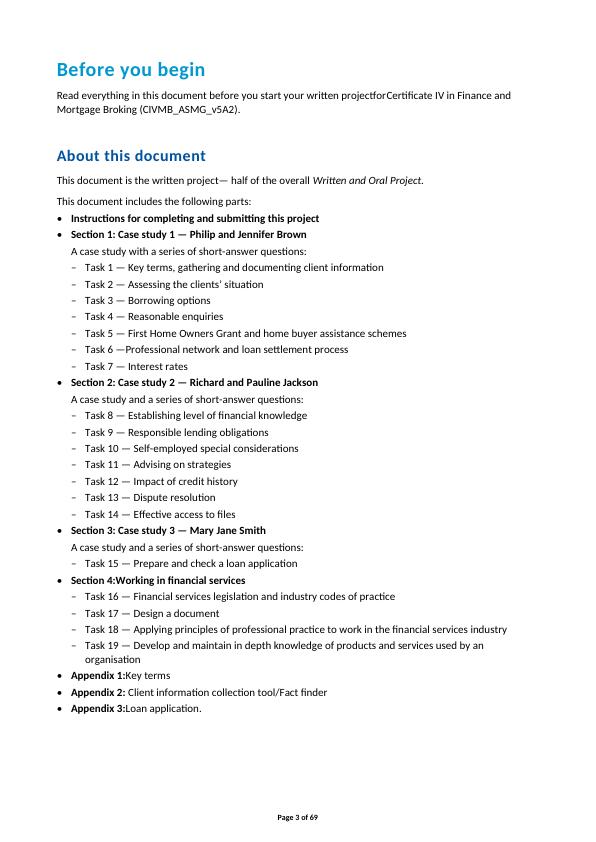
How to use the study plan
We recommend that you use the study plan for this subject to help you manage your time to complete
the written project within your enrolment period. Your study plan is in the KapLearn Certificate IV in
Finance and Mortgage Broking (CIVMBv5) subject room.
Instructions for completing and submitting the
written project
Completing the written project
Saving your work
Download this document to your desktop, type your answers in the spaces provided and save your work
regularly.
• Use the template provided, as other formats will not be accepted for these projects.
• Name your file as follows: Studentnumber_SubjectCode_Project_versionnumber_Submissionnumber
(e.g. 12345678_CIVMB_AS_v5A2_Submission1).
• Include your student ID on the first page of the project.
Before you submit your work, please do a spell check and proofread your work to ensure that everything
is clear and unambiguous.
Word count
The word count shown with each question is indicative only. You will not be penalised for exceeding the
suggested word count. Please do not include additional information which is outside the scope of the
question.
Additional research
When completing the ‘Client information collection tool’in Appendix 2, assumptions are permitted,
although they must not be in conflict with the information provided in the Case study.
Throughout the project you will also be required to research additional information from other
organisations in the finance industry to find the right products or services to meet your client’s
requirements or to calculate any service fees that may be applicable.
Page 4 of 69
We recommend that you use the study plan for this subject to help you manage your time to complete
the written project within your enrolment period. Your study plan is in the KapLearn Certificate IV in
Finance and Mortgage Broking (CIVMBv5) subject room.
Instructions for completing and submitting the
written project
Completing the written project
Saving your work
Download this document to your desktop, type your answers in the spaces provided and save your work
regularly.
• Use the template provided, as other formats will not be accepted for these projects.
• Name your file as follows: Studentnumber_SubjectCode_Project_versionnumber_Submissionnumber
(e.g. 12345678_CIVMB_AS_v5A2_Submission1).
• Include your student ID on the first page of the project.
Before you submit your work, please do a spell check and proofread your work to ensure that everything
is clear and unambiguous.
Word count
The word count shown with each question is indicative only. You will not be penalised for exceeding the
suggested word count. Please do not include additional information which is outside the scope of the
question.
Additional research
When completing the ‘Client information collection tool’in Appendix 2, assumptions are permitted,
although they must not be in conflict with the information provided in the Case study.
Throughout the project you will also be required to research additional information from other
organisations in the finance industry to find the right products or services to meet your client’s
requirements or to calculate any service fees that may be applicable.
Page 4 of 69
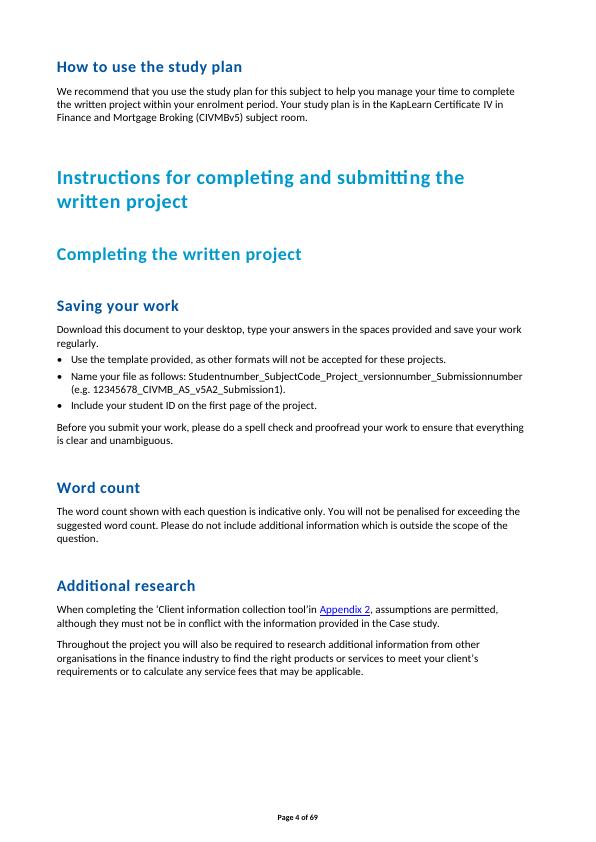
Submitting the writtenproject
Only Microsoft Office compatible written projects submitted in the template file will be accepted for
marking by Kaplan Professional Education. You need to save and submit this entire document.
Do not remove any sections of the document.
Do not save your completed project as a PDF.
The written project must be completed before submitting it to Kaplan Professional Education.
Incomplete written projects will be returned to you unmarked. The written project must be submitted
together with the oral project. If you do not submit both completed projects at the one time it will be
returned to you unmarked.
The maximum file size is 20MB for the written and oral project. Once you submit your written project for
marking you will be unable to make any further changes to it.
Once you submit your written project for marking you will be unable to make any further changes to it.
You are able to submit bothprojects earlier than the deadline if you are confident you have completed all
parts and have prepared a quality submission.
Please refer to the Project submission/resubmission videos in the Assessment section of KapLearn under
your ‘Project Enrolment’ for details on how to submit/resubmit your written project.
Your Written Project and Oral Project must be submitted together on or before your due date. Please
check KapLearn for the due date.
The written project marking process
You have 26 weeks from the date of your enrolment in this subject to submit your completed project.
If you reach the end of your initial enrolment period and have been deemed ‘Not yet demonstrated’ in one
or more assessment items, then an additional four (4) weeks will be granted, provided you attempted all
assessment tasks during the initial enrolment period.
Your assessor will mark your written and oral project and return it to you in the Certificate IV in Finance and
Mortgage Broking (CIVMBv5) subject room in KapLearn under the ‘Assessment’ tab.
Make a reasonable attempt
You must demonstrate that you have made a reasonable attempt to answer all of the questions in
your written project. Failure to do so will mean that your project will not be accepted for marking;
therefore you will not receive the benefit of feedback on your submission.
If you do not meet these requirements, you will be notified. You will then have until your submission
deadline to submit your completedwritten and oral project.
How your written project is graded
Project tasks are used to determine your ‘competence’ in demonstrating the required knowledge and/or
skills for each subject. As a result, you will be graded as either Demonstrated or Not yet demonstrated.
Page 5 of 69
Only Microsoft Office compatible written projects submitted in the template file will be accepted for
marking by Kaplan Professional Education. You need to save and submit this entire document.
Do not remove any sections of the document.
Do not save your completed project as a PDF.
The written project must be completed before submitting it to Kaplan Professional Education.
Incomplete written projects will be returned to you unmarked. The written project must be submitted
together with the oral project. If you do not submit both completed projects at the one time it will be
returned to you unmarked.
The maximum file size is 20MB for the written and oral project. Once you submit your written project for
marking you will be unable to make any further changes to it.
Once you submit your written project for marking you will be unable to make any further changes to it.
You are able to submit bothprojects earlier than the deadline if you are confident you have completed all
parts and have prepared a quality submission.
Please refer to the Project submission/resubmission videos in the Assessment section of KapLearn under
your ‘Project Enrolment’ for details on how to submit/resubmit your written project.
Your Written Project and Oral Project must be submitted together on or before your due date. Please
check KapLearn for the due date.
The written project marking process
You have 26 weeks from the date of your enrolment in this subject to submit your completed project.
If you reach the end of your initial enrolment period and have been deemed ‘Not yet demonstrated’ in one
or more assessment items, then an additional four (4) weeks will be granted, provided you attempted all
assessment tasks during the initial enrolment period.
Your assessor will mark your written and oral project and return it to you in the Certificate IV in Finance and
Mortgage Broking (CIVMBv5) subject room in KapLearn under the ‘Assessment’ tab.
Make a reasonable attempt
You must demonstrate that you have made a reasonable attempt to answer all of the questions in
your written project. Failure to do so will mean that your project will not be accepted for marking;
therefore you will not receive the benefit of feedback on your submission.
If you do not meet these requirements, you will be notified. You will then have until your submission
deadline to submit your completedwritten and oral project.
How your written project is graded
Project tasks are used to determine your ‘competence’ in demonstrating the required knowledge and/or
skills for each subject. As a result, you will be graded as either Demonstrated or Not yet demonstrated.
Page 5 of 69
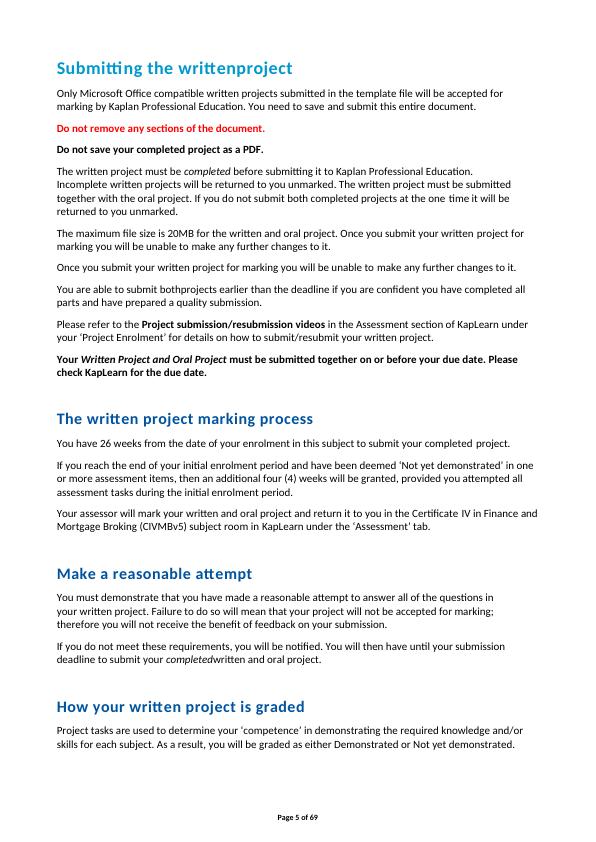
Your assessor will follow the below process when marking your project:
• Assess your responses to each question, and sub-parts if applicable, and then determine whether you
have demonstrated competence in each question.
• Determine if, on a holistic basis, your responses to the questions have demonstrated overall
competence.
You must be deemed to be demonstrated in all assessment items in order to be awarded the units
of competency in this subject, including:
• all of the exam questions
• the written and oral project.
‘Not yet demonstrated’and resubmissions
Should sections of your project be marked as ‘not yet demonstrated’you will be given an additional
opportunity to amend your responses so that you can demonstrate your competency to the required level.
You must address the assessor’s feedback in your amended responses. You only need amend those sections
where the assessor has determined you are ‘not yet demonstrated’.
Make changes to your original submission. Use a different text colour for your resubmission. Your assessor
will be in a better position to gauge the quality and nature of your changes. Ensure you leave your first
assessor’s comments in your project, so your second assessor can see the instructions that were originally
provided for you. Do not change any comments made by a Kaplan assessor.
Units of competency
This written project is your opportunity to demonstrate your competency against these units:
FNSCRD301 Process applications for credit
FNSFMB401 Prepare a loan application on behalf of finance or mortgage broking clients
FNSFMB402 Identify client needs for broking services
FNSFMB403 Present broking options to client
FNSFMK505 Comply with financial services legislation and industry codes of practice
FNSINC401 Apply principles of professional practice to work in the financial services industry
FNSINC402 Develop and maintain in-depth knowledge of products and services used by an organisation or sector
BSBITU306 Design and produce business documents
BSBCUS301 Deliver and monitor a services to customers
BSBCUS402 Address customer needs
FNSSAM403 Prospect for new clients
FNSFMB501 Settle applications and loan arrangements in the finance and mortgage broking industry
Note that the written and oral project is one of two assessments required to meet the requirements of the
units of competency.
We are here to help
If you have any questions about this written project you can post your query at the ‘Ask your Tutor’ forum
in your subject room. You can expect an answer within 24 hours of your posting from one of our technical
advisers or student support staff.
Page 6 of 69
• Assess your responses to each question, and sub-parts if applicable, and then determine whether you
have demonstrated competence in each question.
• Determine if, on a holistic basis, your responses to the questions have demonstrated overall
competence.
You must be deemed to be demonstrated in all assessment items in order to be awarded the units
of competency in this subject, including:
• all of the exam questions
• the written and oral project.
‘Not yet demonstrated’and resubmissions
Should sections of your project be marked as ‘not yet demonstrated’you will be given an additional
opportunity to amend your responses so that you can demonstrate your competency to the required level.
You must address the assessor’s feedback in your amended responses. You only need amend those sections
where the assessor has determined you are ‘not yet demonstrated’.
Make changes to your original submission. Use a different text colour for your resubmission. Your assessor
will be in a better position to gauge the quality and nature of your changes. Ensure you leave your first
assessor’s comments in your project, so your second assessor can see the instructions that were originally
provided for you. Do not change any comments made by a Kaplan assessor.
Units of competency
This written project is your opportunity to demonstrate your competency against these units:
FNSCRD301 Process applications for credit
FNSFMB401 Prepare a loan application on behalf of finance or mortgage broking clients
FNSFMB402 Identify client needs for broking services
FNSFMB403 Present broking options to client
FNSFMK505 Comply with financial services legislation and industry codes of practice
FNSINC401 Apply principles of professional practice to work in the financial services industry
FNSINC402 Develop and maintain in-depth knowledge of products and services used by an organisation or sector
BSBITU306 Design and produce business documents
BSBCUS301 Deliver and monitor a services to customers
BSBCUS402 Address customer needs
FNSSAM403 Prospect for new clients
FNSFMB501 Settle applications and loan arrangements in the finance and mortgage broking industry
Note that the written and oral project is one of two assessments required to meet the requirements of the
units of competency.
We are here to help
If you have any questions about this written project you can post your query at the ‘Ask your Tutor’ forum
in your subject room. You can expect an answer within 24 hours of your posting from one of our technical
advisers or student support staff.
Page 6 of 69

Section 1: Case study 1 — Philip and Jennifer Brown
Background
Philip and Jennifer Brown are a young couple about to buy their first home. They have been married for
five years and during that time have rented an apartment while saving for their own home.
Following a personal referral from Glenn Brown, Philip’s brother you have already had a first meeting with
Philip and Jennifer to discuss their objectives and needs. They admitted they have little time to do much
research of lenders, have limited knowledge of the loan products available and have approached you to
guide them through the process as they are confused.
During (and subsequent) to your first meeting, Philip and Jennifer have provided the basic information
documents — pay slips, tax returns, bank statements, property details for review/verification. You have
now undertaken your preliminary assessment and need to discuss and present to them the proposal
covering the options and your recommendations. It is important to get the proposal moving quickly,
as the agent has indicated other parties are interested in the property.
They have been looking at properties for the past three months and have found a 10 year old established
apartment that has really caught their eye, although they have some concern over the kitchen which
requires some minor renovations.
They have not paid a deposit at this stage, but the Real Estate Agent has provided some guidance on
additional fees and charges.
Following is a summary of the details of the property they wish to purchase, the couple’s financial and
employment details, and the loan features they require.
The property
Address Unit 1, 92 Seaside Lane Edgartown (Your state)
Purchase price $490,000
Description 2 bedroom, 2 bathroom Strata Title apartment
Agent details Stephanie Jones
Phone 8123 1113
Mobile 0412 880 088
The couple
Current address Unit 12, 22 Wentworth Lane, Highville, (Your state)
Philip and Jennifer have lived there since March 2012
Home phone 9123 2121
Page 7 of 69
Background
Philip and Jennifer Brown are a young couple about to buy their first home. They have been married for
five years and during that time have rented an apartment while saving for their own home.
Following a personal referral from Glenn Brown, Philip’s brother you have already had a first meeting with
Philip and Jennifer to discuss their objectives and needs. They admitted they have little time to do much
research of lenders, have limited knowledge of the loan products available and have approached you to
guide them through the process as they are confused.
During (and subsequent) to your first meeting, Philip and Jennifer have provided the basic information
documents — pay slips, tax returns, bank statements, property details for review/verification. You have
now undertaken your preliminary assessment and need to discuss and present to them the proposal
covering the options and your recommendations. It is important to get the proposal moving quickly,
as the agent has indicated other parties are interested in the property.
They have been looking at properties for the past three months and have found a 10 year old established
apartment that has really caught their eye, although they have some concern over the kitchen which
requires some minor renovations.
They have not paid a deposit at this stage, but the Real Estate Agent has provided some guidance on
additional fees and charges.
Following is a summary of the details of the property they wish to purchase, the couple’s financial and
employment details, and the loan features they require.
The property
Address Unit 1, 92 Seaside Lane Edgartown (Your state)
Purchase price $490,000
Description 2 bedroom, 2 bathroom Strata Title apartment
Agent details Stephanie Jones
Phone 8123 1113
Mobile 0412 880 088
The couple
Current address Unit 12, 22 Wentworth Lane, Highville, (Your state)
Philip and Jennifer have lived there since March 2012
Home phone 9123 2121
Page 7 of 69

Funds position
Purchase price $490,000
Clients’ estimate of costs $25,000
Total required $515,000
Loan $440,000 + LMI
Clients’ total contribution (including deposit of $50,000) $75,000
Use fees and charges applicable to your state. If a servicing calculator you are using requires a postcode,
select one that would represent a reasonable suburb/location in your city or state.
Assets
Capital Bank savings account (joint) $78,000
Capital Bank cheque account (joint) $1600
Holden Commodore SS 2007 (Philip) $25,000
Kia Cerato Sport 2015 (Jennifer) $9000
Superannuation — Capital Bank (Philip) $28,000
Superannuation — Capital Bank (Jennifer) $62,000
Household effects (insured value) $40,000
Liabilities
Capital Bank personal loan (Philip) $5,600 (repayments $180 p.m.)
Capital Bank Visa card (Philip) $200 (limit $4,000)
Capital Bank Visa card (Jennifer) $1,600 (limit $5,000)
Payments have always been met on time and any prior loans repaid in terms of contracts. The minimum
monthly commitment on each of the credit cards should be calculated at 3% of the credit limit.
Living expenses
Annual expenditure for living expenses — $33,000.
Page 8 of 69
Purchase price $490,000
Clients’ estimate of costs $25,000
Total required $515,000
Loan $440,000 + LMI
Clients’ total contribution (including deposit of $50,000) $75,000
Use fees and charges applicable to your state. If a servicing calculator you are using requires a postcode,
select one that would represent a reasonable suburb/location in your city or state.
Assets
Capital Bank savings account (joint) $78,000
Capital Bank cheque account (joint) $1600
Holden Commodore SS 2007 (Philip) $25,000
Kia Cerato Sport 2015 (Jennifer) $9000
Superannuation — Capital Bank (Philip) $28,000
Superannuation — Capital Bank (Jennifer) $62,000
Household effects (insured value) $40,000
Liabilities
Capital Bank personal loan (Philip) $5,600 (repayments $180 p.m.)
Capital Bank Visa card (Philip) $200 (limit $4,000)
Capital Bank Visa card (Jennifer) $1,600 (limit $5,000)
Payments have always been met on time and any prior loans repaid in terms of contracts. The minimum
monthly commitment on each of the credit cards should be calculated at 3% of the credit limit.
Living expenses
Annual expenditure for living expenses — $33,000.
Page 8 of 69

End of preview
Want to access all the pages? Upload your documents or become a member.
Related Documents
Case Study 1: Philip and Jennifer Brownlg...
|68
|18816
|493
Case Study 1: Philip and Jennifer Brownlg...
|86
|17614
|31
Case Study 1: Philip and Jennifer Brownlg...
|46
|12110
|114
Case Study 1: Philip and Jennifer Brownlg...
|91
|19289
|44
Industry Knowledge and the Lending Processlg...
|51
|16017
|1
Case Study 1: Philip and Jennifer Brownlg...
|57
|15464
|78
